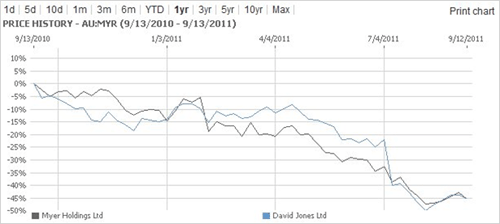With these two companies competing for your investment dollars – which should you buy? Let’s examine them both…
The Skinny on David Jones (DJS)
David Jones Limited is an upmarket retailer with 35 department stores and 2 warehouse outlets across Australia. They carry a broad range of high-end fashion, electronics, and classy kitchenware.
What about their income and balance sheets? They carry a whopping 10.2% dividend yield that is fully franked. Is this massive dividend sustainable? We need to dig a bit deeper to find out.
Sales growth is the foundation for all company growth – if sales fall you cannot sustain earnings growth for long. David Jones has a low 2.66% 5-year average sales growth, although the last year saw a 3.4% rise in revenue. Yet, some of this low growth is priced in as the price-to-earnings multiple sits at 8.5 while the industry itself is almost double that.
On a positive note, the company is able to squeeze more out of every dollar of sales than the industry can as the current net profit margin is 8.6% while the industry sits at 4.4%. In these economic times you like to see a company keeping more of each dollar. Debt is relatively low, which is good.
However, as the global economic crises plays out – consumers will often turn to lower priced alternatives to save a few dollars. Perhaps this is why analysts on average expect sales and earnings to decline for the next 5 years at a rate of 15.55%. Over the past year the share price has reflected this sentiment as prices have fallen from $5 to well under $3.
The Skinny on Myer Holding (MYR)
Myer is Australia’s largest department store chain that carries a variety of products from fashion to furniture, toys, and TVs. Due to plunging share prices, the current yield also sits high at 9.96%.
Sales have steadily dipped slightly since 2007, although they are expected to improve in 2012. The earnings forecast paint a bleaker picture with the next 5 years expected to see declining growth at a rate of 9.18%. On another dismal note – the net profit margins are only half of what the industry average is – and only one quarter of David Jones.
The price-to-earnings ratio sits at 18.1, which is a couple points higher than industry averages.
David Jones VS Myer: The Winner?
As you can see, both stocks have been racing to lose value over the past year.

That makes both these stocks contrarian picks where the investor is anticipating a turnaround instead of following a winning trend. On one hand we have an smaller upscale chain in a soft market against a larger store group with a mixed bag of fundamentals.
It is a close decision but due to David Jones ability to retain more of every dollar and a much lower price-to-earnings ratio, which might indicate that investors have already priced in much of the forecasted negative earnings growth, I give it to the upmarket chain…by a little. It is not the clear and decisive win I had hoped for, but it would be fair to say that I feel David Jones is the better positioned of the two strugglers.